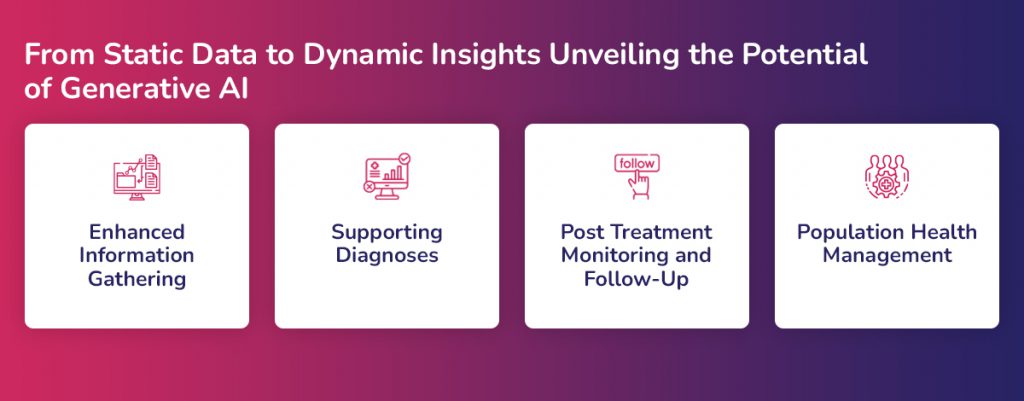The healthcare landscape is undergoing a dramatic transformation. Patients are no longer passive recipients of care, actively seeking information online to understand their conditions. This trend has been significantly amplified by the emergence of generative Artificial Intelligence (AI). While traditional AI focuses on analyzing existing data, generative AI creates entirely new content. This, coupled with user-friendly interfaces, has led to its rapid adoption by medical professionals.
However, the integration of generative AI into healthcare is not without its challenges. Let’s delve deeper into this fascinating technology, exploring its potential applications, limitations, and the policy considerations that will guide its responsible development and deployment.
From Static Data to Dynamic Insights: Unveiling the Potential of Generative AI
Generative AI thrives in repetitive, low-risk environments. Here’s how it can revolutionize various healthcare functions:
Enhanced Information Gathering:
Imagine an AI assistant that conversationally gathers patient medical history, clarifies ambiguities, and summarizes data for physicians. Generative AI can tap into Health Information Exchanges (HIEs) to retrieve medical records, analyze them, and formulate relevant questions based on a patient’s background. This not only streamlines information collection but also empowers patients who are already comfortable with AI in other aspects of their lives. Consider a scenario where a patient walks into a clinic with concerns about fatigue and headaches. The AI assistant, after a brief conversation, can ask targeted questions about the patient’s sleep patterns, dietary habits, and medication use. It can then access the patient’s medical history through the HIE, flagging potential interactions between medications or highlighting historical diagnoses that might be relevant. This comprehensive picture empowers the physician to delve deeper into the patient’s condition and arrive at a more accurate diagnosis.

Supporting Diagnoses:
AI has shown promise in aiding diagnoses, especially for well-documented conditions. However, challenges remain for less common diseases with limited data. Currently, available generative AI models, like ChatGPT, rely on publicly available data, which is insufficient for medical diagnostics. Physicians should leverage AI cautiously until it can be trained on extensive, anonymized medical datasets. Here, the role of AI is to be a valuable assistant, highlighting potential diagnoses for physician evaluation, not a replacement for their expertise. Imagine a patient presenting with a rare skin condition. The AI, after analyzing the patient’s symptoms and images, can generate a list of possible diagnoses, including the rare condition. This list, along with its supporting rationale and relevant medical literatu re, can guide the physician towards further investigations and potentially a faster and more accurate diagnosis.
Post-Treatment Monitoring and Follow-Up:
Generative AI holds immense potential in this arena. Patient adherence to post-treatment plans is crucial, but ensuring it can be difficult. The rise of wearable technology and sensor-equipped devices creates an opportunity for AI to leverage this data for real-time monitoring and personalized recommendations. This can empower medical providers to proactively intervene when a patient’s health deteriorates. For instance, a patient recovering from heart surgery might wear a smartwatch that monitors heart rate and activity levels. The AI, analyzing this data, can detect concerning trends and prompt the patient to contact their doctor or adjust their medication regimen based on pre-defined protocols established by the physician.
Population Health Management:
Generative AI can analyze vast datasets from electronic health records (EHRs) and HIEs to identify at-risk patients who would benefit from timely interventions. For instance, AI algorithms can assess the likelihood of hospital readmissions and guide the creation of customized care plans to prevent future complications. However, the effectiveness of such models hinges on the availability of comprehensive datasets that include not just medical history but also social determinants of health, lifestyle choices, and daily activities. Integration of data from wearable devices can provide a more holistic view of a patient’s health, leading to more accurate predictions and effective interventions. Imagine a community health program aiming to reduce diabetes complications. Generative AI can analyze data from EHRs, wearable devices, and even social determinants like access to healthy food options to identify individuals at high risk of developing diabetic foot ulcers. This allows the program to proactively target these individuals with preventive measures like educational resources and podiatric care.
The Road Ahead: Navigating the Ethical and Regulatory Landscape
As we embrace generative AI in healthcare, ethical considerations and robust policies are paramount:
Transparency:
To foster trust, a collaboration between AI developers and healthcare professionals is essential. AI recommendations should be transparent, allowing healthcare professionals to scrutinize the underlying data and algorithms for accuracy. Imagine a scenario where the AI flags a potential medication interaction for a patient. Transparency would require the AI to not only highlight the interaction but also explain the reasoning behind its conclusion, allowing the physician to assess the risk and make an informed decision.
Informed Consent:
Patients have the right to understand how AI is used in their care journey. Informed consent must encompass not only the use of traditional medical records but also data collected from wearables and smart devices. Educating patients about data privacy and the potential risks and benefits of AI is crucial for building trust.
For instance, a patient might be hesitant to wear a health-monitoring smartwatch due to privacy concerns. A robust informed consent process would explain how their data is anonymized, secured, and used solely for their healthcare benefit. Additionally, it would outline the potential benefits of AI-powered insights gleaned from the wearable data. This transparency empowers patients to make informed decisions about their participation in AI-driven healthcare initiatives.
Breaking Data Monopolies:
Large healthcare providers with access to vast amounts of data could potentially leverage AI to gain a competitive advantage. To prevent this, industry leaders and regulatory bodies should work together to democratize access to medical data for AI development. HIEs can play a pivotal role by aggregating data from various providers, ensuring that all healthcare institutions, regardless of size, can benefit from AI insights. This collaborative approach will foster a more equitable healthcare landscape where technology bridges divide rather than create them.
Imagine a scenario where a small, rural clinic lacks the resources to invest in cutting-edge AI technology. By participating in a regional HIE that leverages anonymized data from multiple institutions, the clinic can access AI-powered insights that would otherwise be unavailable. This empowers the small clinic to offer its patients a level of care comparable to larger institutions, narrowing the gap in healthcare quality across different communities.
Addressing Algorithmic Bias:
AI algorithms are only as good as the data they are trained on. Biases present in historical datasets can be perpetuated by AI, leading to discriminatory practices. For instance, an AI model trained on data from a predominantly white population might struggle to accurately diagnose skin conditions in patients of color. Mitigating algorithmic bias requires a multi-pronged approach. Healthcare institutions must ensure their datasets are diverse and representative of the population they serve. Additionally, AI developers should implement rigorous fairness checks throughout the development process.
Addressing Cybersecurity Threats:
The increasing reliance on digital healthcare records and AI-powered systems necessitates robust cybersecurity measures. Data breaches can expose sensitive patient information and disrupt healthcare operations. Investing in cutting-edge cybersecurity solutions and fostering a culture of data security awareness among healthcare professionals are crucial steps in mitigating these risks.
The Future of Human-AI Collaboration:
Generative AI is not a replacement for human expertise; it is a powerful tool that can augment the capabilities of healthcare professionals. Physicians will continue to play a central role in diagnosis, treatment decisions, and patient communication. However, AI can streamline workflows, provide valuable insights, and empower healthcare professionals to deliver more personalized and effective care.
Imagine a future where a physician, armed with AI-powered insights gleaned from a patient’s medical history, wearable data, and social determinants of health, can tailor a treatment plan that addresses not just the patient’s medical condition but also the underlying social factors that might be impacting their health. This holistic approach, driven by a synergistic collaboration between human expertise and machine intelligence, has the potential to revolutionize healthcare delivery.
Conclusion
Generative AI offers a transformative vision for healthcare, promising to streamline processes, enhance diagnoses, and improve patient outcomes. However, responsible development and deployment are crucial. By prioritizing transparency, informed consent, and equitable access to data, we can harness the power of AI to build a future where human expertise and machine intelligence work together to create a healthier world for all. This journey requires ongoing collaboration between AI developers, healthcare professionals, policymakers, and the public. By fostering a culture of innovation, responsibility, and ethical considerations, we can ensure that generative AI becomes a powerful force for good in the ever-evolving landscape of healthcare.






